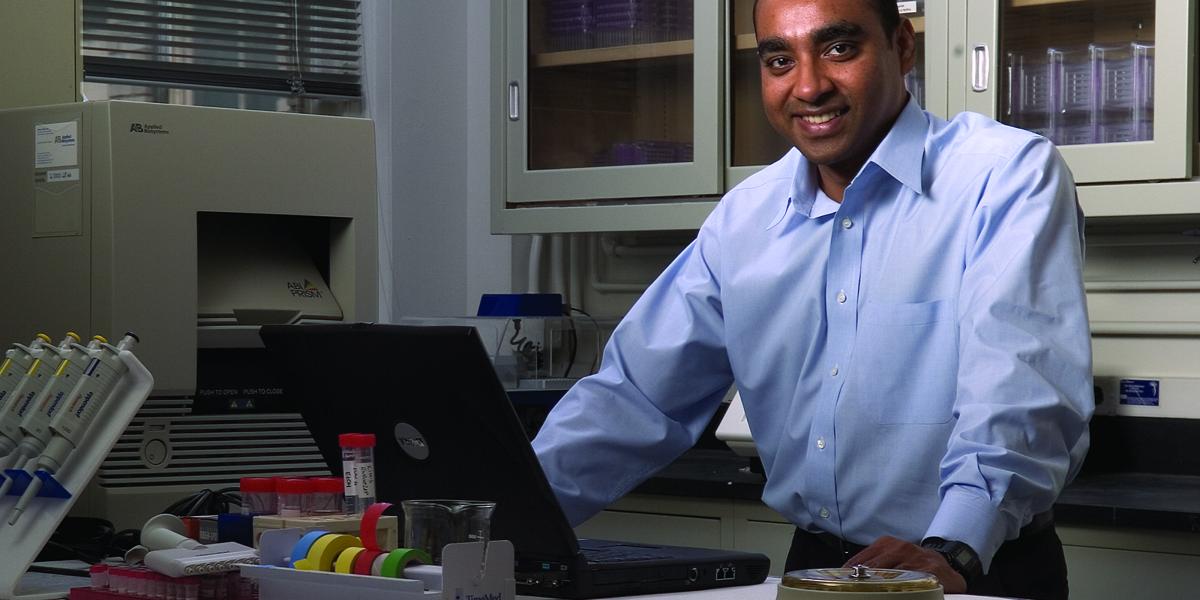Bolstering the Body's Defenses
The body's immune system forms an astoundingly effective first line of defense against foreign pathogens. But sometimes it needs a little help.
The "Master Regulator" and Lung Disease
Every cell in the human body has its own rapid reaction force, an army of genes and proteins poised to defend the cell. When attacked by toxins or carcinogens, the cell responds immediately. "If you're exposed to diesel exhaust or smoke, [scores of] antioxidant genes are expressed. The cell fights back," says Shyam Biswal, PhD, assistant professor of Environmental Health Sciences.
Using modern genomics technology, Biswal and colleagues found the commander in chief of this cellular army in 2002. It's a gene known as Nrf2. Biswal proved Nrf2's role as "master regulator" by demonstrating how it mustered a network of genes to confront carcinogens in response to a chemopreventive agent called sulforaphane. To accomplish this, he used a gene chip that contains information for the entire mouse genome. Rather than study just one gene at a time, researchers like Biswal can now use gene chips to monitor the complex interaction of thousands of proteins within an organism's entire genome. Understanding the body's defenses against toxins and carcinogens is critical because environmental factors play a role in 85 percent of all human disease.
Biswal has recently focused on Nrf2's role in defending the lungs against environmental pollutants and other agents that trigger inflammation. In this latest study, Biswal exposed two sets of mice to cigarette smoke. One group of mice was genetically engineered to "knock out" the Nrf2 gene; the other group was normal. Biswal found that the mice lacking the Nrf2 gene had early onset and more severe emphysema in response to cigarette smoke. "Our studies showed that Nrf2 must be a major player in determining susceptibility to various lung inflammatory diseases," says Biswal.
His future research will investigate Nrf2's role in preventing other diseases like lung cancer and colon cancer. "Every smoker should get lung cancer, but only 1 in 10 does," he says. "We are exploring the possibility that mutations in the Nrf2 gene may lead to differences in expression of antioxidants and carcinogen-inactivating genes."
The research by Biswal and scientists like him has huge import for future human health. With growing command of genomics and proteomics, scientists will be able to pinpoint genetic variations in individuals that render them susceptible to a given disease. "You can identify high-risk individuals before disease outcomes are apparent," says Biswal. "This allows you to do early interventions. And early interventions are key to saving lives."
Harnessing Microbicides in the Battle Against STDs
Women may soon have a better way to protect themselves from HIV and other sexually transmitted diseases (STDs), thanks to a new class of germ-fighting compounds called microbicides. Reproductive health experts believe this new class of microbe fighter may be as significant for the control of STDs in women as the Pill has been in regulating fertility—potentially lifesaving news for women around the world, who are at least four times more vulnerable to HIV infection than men.
Richard Markham, MD, a professor of Molecular Microbiology and Immunology, and his colleagues are working to develop a microbicide that actually prompts the wall of the vagina to become more impermeable to infection during intercourse, preventing HIV from getting inside the body.
The vagina is lined with a thick layer of epithelial cells that cannot become infected by HIV because they lack the receptors needed by the virus to gain a foothold. But HIV can circumvent this barrier by instead infecting white blood cells in the male's sperm fluid, which are able to attach themselves to the vaginal wall and then easily infiltrate the epithelium. Interfere with that adhesion process, reasoned Markham and his team, and HIV could be foiled.
Sure enough, when the researchers created an antibody against the intercellular adhesion molecule-1 (ICAM-1) and introduced it along with HIV into the vaginas of a special HIV-susceptible mouse strain, the number of HIV-infected white cells able to permeate the epithelium and gain access to the body was reduced by 90 percent—this in a laboratory situation highly skewed to promote infection.
Through the microscope, the scientists discovered that ICAM-1, when bound by the antibody, gives off a chemical signal that causes the epithelial cells to bind more tightly together, making it impossible for the infected cells to squeeze between them.
Now that Markham and his team have an antibody against ICAM-1, their goal is to get this antibody produced for extended periods in the vagina. They are looking to Lactobacillus, a bacterium native to the female genitourinary tract, because bacteria can often be genetically engineered to produce human antibodies.
The scientists are working with researchers in Sweden who believe they can indeed genetically coax Lactobacillus into manufacturing the anti-ICAM-1 antibody. "If we can get this delivery system working," says Markham, "and perfect the targeting of HIV, we can work next on getting Lactobacillus to express antibodies to other STDs."
